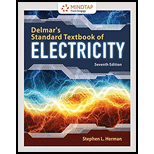
EBK MINDTAP FOR HERMAN'S DELMAR'S STAND
7th Edition
ISBN: 9781337900614
Author: Herman
Publisher: VST
expand_more
expand_more
format_list_bulleted
Textbook Question
Chapter 34, Problem 2PA
Refer to the preceding Practical Application. When the 30-HP motor is replaced with the 50-HP, will the existing motor starter have to be replaced? If so, what size starter should be selected? A NEMA size 3 starter was used for the 30-HP motor.
Expert Solution & Answer
Want to see the full answer?
Check out a sample textbook solution
Students have asked these similar questions
An electrical substation had a sudden discharge arc event lasting 0.005 seconds. The event produced 768,000 volts that conducted 500 amperes to a nearby grounded metal strap and opened a 500 ampere protective breaker.
(a) How much power was produced by the electrical discharge?
(b) How much energy was in the discharge?
(c) How long could a 75 watt light bulb stay lit, if all the energy in the arc was used to operate it?
I need help with this problem and an explanation of the solution for the image described below. (Introduction to Signals and Systems)
Find Rth at open terminals using a 1V test source.
Chapter 34 Solutions
EBK MINDTAP FOR HERMAN'S DELMAR'S STAND
Ch. 34 - Which NEC table is used to determine the full...Ch. 34 - A 5-HP single-phase motor is connected to 208...Ch. 34 - A 10-HP single-phase motor is connected to 240...Ch. 34 - A 75-HP synchronous motor is connected to a...Ch. 34 - A squirrel-cage induction motor has a nameplate...Ch. 34 - A squirrel-cage motor has a nameplate current...Ch. 34 - A 100-HP three-phase squirrel-cage induction motor...Ch. 34 - A 60-HP synchronous motor is connected to 240...Ch. 34 - Prob. 9RQCh. 34 - Both the motors and the feeder in Question 9 are...
Ch. 34 - A 30-HP squirrel-cage induction motor is connected...Ch. 34 - Refer to the preceding Practical Application. When...Ch. 34 - Refer to the first Practical Application in this...Ch. 34 - A 10-HP single-phase motor is connected to 240...Ch. 34 - A 500-HP synchronous motor is connected to 2300...Ch. 34 - A 30-HP three-phase squirrel-cage induction motor...Ch. 34 - A 75-HP synchronous motor is connected to a...Ch. 34 - Prob. 5PPCh. 34 - A 350-HP squirrel-cage induction motor is...Ch. 34 - Three squirrel-cage motors are connected to a...
Knowledge Booster
Learn more about
Need a deep-dive on the concept behind this application? Look no further. Learn more about this topic, electrical-engineering and related others by exploring similar questions and additional content below.Similar questions
- I need help with this problem and an explanation of the solution for the image described below. (Introduction to Signals and Systems)arrow_forwardFind Rth at the open terminals using a 1V test source.arrow_forwardI need help with this problem and an explanation of the solution for the image described below. (Introduction to Signals and Systems)arrow_forward
- Find Rth at the open terminals using 1V test source.arrow_forwardHow many atoms are there in a simple cubic unit cell? in a bcc unit cell? in a fcc unit cell? in the unit cell characterizing the diamond lattice?arrow_forwardConsider the homogeneous RLC circuit (no voltage source) shown in the diagram below. Before the switch is closed, the capacitor has an initial charge go and the circuit has an initial current go- R 9(1) i(t)↓ After the switches closes, current flows through the circuit and the capacitor begins to discharge. The equation that describes the total voltage in the loop comes from Kirchoff's voltage law: L di(t) + Ri(t)+(0) = 0, (1) where i(t) and q(t) are the current and capacitor charge as a function of time, L is the inductance, R is the resistance, and C is the capacitance. Using the fact that the current equals the rate of change of the capacitor charge, and dividing by L, we can write the following homogeneous (no input source) differential equation for the charge on the capacitor: 4(1) +29(1)+w79(1)=0, ཀྱི where a= R 2L and The solution to this second order linear differential equation can be written as: 9(1) =Aent - Beat, where (3) (4) (5) A= (81+20)90 +90 (82+20)90 +90 and B= (6)…arrow_forward
- Consider the homogeneous RLC circuit (no voltage source) shown in the diagram below. Before the switch is closed, the capacitor has an initial charge go and the circuit has an initial current go. R w i(t) q(t) C н After the switches closes, current flows through the circuit and the capacitor begins to discharge. The equation that describes the total voltage in the loop comes from Kirchoff's voltage law: di(t) L + Ri(t) + (t) = 0, dt (1) where i(t) and q(t) are the current and capacitor charge as a function of time, L is the inductance, R is the resistance, and C is the capacitance. Using the fact that the current equals the rate of change of the capacitor charge, and dividing by L, we can write the following homogeneous (no input source) differential equation for the charge on the capacitor: ä(t)+2ag(t)+wg(t) = 0, (2) where R a 2L and w₁ = C LC The solution to this second order linear differential equation can be written as: where 81= q(t) = Ae³¹- Bel 82 = (3) (4) (5)arrow_forwardI need help with this problem and an explanation of the solution for the image described below. (Introduction to Signals and Systems)arrow_forwardFind Rth at open terminals using a 1V test source.arrow_forward
arrow_back_ios
SEE MORE QUESTIONS
arrow_forward_ios
Recommended textbooks for you
 Electricity for Refrigeration, Heating, and Air C...Mechanical EngineeringISBN:9781337399128Author:Russell E. SmithPublisher:Cengage Learning
Electricity for Refrigeration, Heating, and Air C...Mechanical EngineeringISBN:9781337399128Author:Russell E. SmithPublisher:Cengage Learning Delmar's Standard Textbook Of ElectricityElectrical EngineeringISBN:9781337900348Author:Stephen L. HermanPublisher:Cengage Learning
Delmar's Standard Textbook Of ElectricityElectrical EngineeringISBN:9781337900348Author:Stephen L. HermanPublisher:Cengage Learning

Electricity for Refrigeration, Heating, and Air C...
Mechanical Engineering
ISBN:9781337399128
Author:Russell E. Smith
Publisher:Cengage Learning

Delmar's Standard Textbook Of Electricity
Electrical Engineering
ISBN:9781337900348
Author:Stephen L. Herman
Publisher:Cengage Learning

How do Universal Motors work ?; Author: Lesics;https://www.youtube.com/watch?v=0PDRJKz-mqE;License: Standard Youtube License